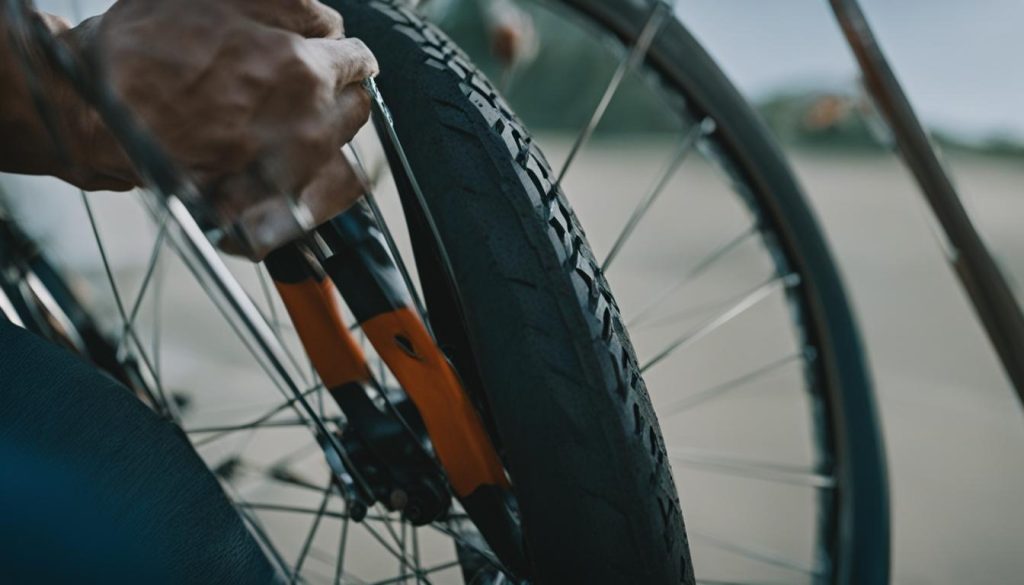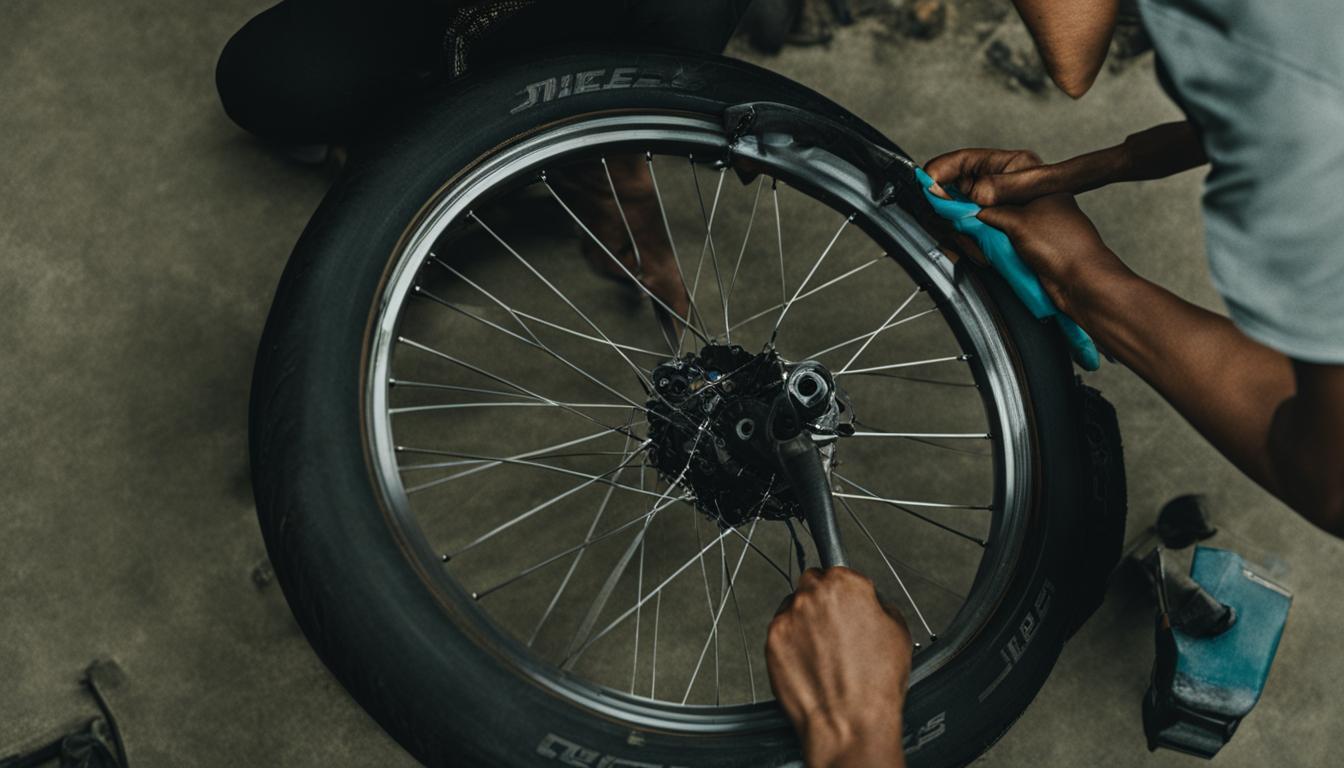Changing a bike tire after getting a flat is a relatively easy fix. With the right tools and knowledge, you can quickly get back on the road. In this guide, we will walk you through the step-by-step process of changing a bike tire, providing you with the necessary information to master this essential skill.
Read More : Cycling for families: Tips for getting the whole family on bikes
Before we dive into the details, let’s quickly go over the basic tools you will need for changing a bike tire. Make sure you have a set of tire levers, a correctly-sized spare tube, and an inflation device handy. These tools will ensure a smooth and efficient tire change.
Key Takeaways:
- Changing a bike tire is a simple process that can be easily mastered.
- Having the right tools, such as tire levers, spare tubes, and an inflation device, is crucial for a successful tire change.
- Regular maintenance and inspection of your bike tires can help prevent flats and ensure a smooth ride.
- By following the step-by-step instructions in this guide, you will gain the confidence to handle any flat tire situation.
- Remember to always carry the necessary tools and equipment for bike tire repair.
How to Change a Tubeless Bike Tire
Changing a tubeless bike tire is a fairly straightforward process that can be done at home with the right tools and a little know-how. Whether you want to DIY your bike tire change or simply want some maintenance tips, this step-by-step guide will walk you through the process.
Gather the necessary tools
Before you start changing your tubeless bike tire, make sure you have the following tools handy:
- Tire levers
- Tire sealant
- A tire pump or CO2 inflator
- A valve core remover
Having these tools will ensure a quick and easy tire change.
Remove the wheel
Start by removing the wheel from your bike. This can usually be done by loosening the quick-release lever or removing the axle nuts. Once the wheel is off, deflate the tire completely by pressing down on the valve core with the valve core remover tool.
Break the bead
Next, use your tire levers to break the bead on the tire. Insert the levers between the tire and the rim, then pry the tire away from the rim. Work your way around the entire circumference of the tire until the bead is completely disconnected from the rim.
Remove the tire
With the bead broken, you can now remove the tire from the rim. Start by grabbing the tire with both hands and pulling it away from the rim. Once you’ve loosened it, you should be able to slide it off the side of the rim with relative ease.
Install the new tire
Now it’s time to install the new tire. Begin by lining up one side of the tire with the rim, then use your thumbs to push the bead onto the rim all the way around. Once one side is on, do the same for the other side, being careful not to pinch the inner tube or damage the valve.
Seal and inflate
Before you fully inflate the tire, it’s important to add sealant. Use a valve core remover to remove the valve core, then pour the recommended amount of sealant into the tire. Reinstall the valve core and tighten it securely. Once the sealant is added, inflate the tire to the recommended pressure using a pump or CO2 inflator.
And there you have it – you’ve successfully changed a tubeless bike tire! With these easy steps, you’ll be back on the road in no time. Remember to regularly check your tire pressure and inspect your tires for any signs of wear or damage to avoid any unexpected tire changes during your rides.

Table: Tools for Changing a Tubeless Bike Tire
| Tire Levers | Essential for prying the tire off the rim |
|---|---|
| Tire Sealant | Helps to seal punctures in tubeless tires |
| Tire Pump or CO2 Inflator | Used to inflate the tire once it’s installed |
| Valve Core Remover | Allows you to remove and reinstall the valve core |
Conclusion
Fixing a flat bike tire doesn’t have to be a daunting task. With a few simple tricks, you can quickly get back on the road and continue your biking adventures. Remember to inspect your tires regularly to catch any potential issues before they become a flat tire. Prevention is key!
Carrying the necessary tools and equipment for bike tire repair, such as tire levers, spare tubes, and an inflation device, is essential. These items will be your best friends when you find yourself with a flat tire. Being prepared will save you time and frustration.
By following the step-by-step instructions provided in this guide, you’ll become proficient in changing a bike tire. The more you practice, the more confident you’ll become in handling any flat tire situation that comes your way. Don’t let a flat tire ruin your ride – tackle it head-on and keep pedaling!
FAQ
Is changing a bike tire difficult?
No, changing a bike tire is a relatively easy fix that can be done with the right tools and knowledge.
What tools do I need to change a bike tire?
To change a bike tire, you will need a set of tire levers, a correctly-sized spare tube, and an inflation device. If you run tubeless tires, there are specific steps for tubeless tire changing.
How do I change a tubeless bike tire?
Changing a tubeless bike tire follows a similar process to changing a tire with a tube. However, there are a few key differences. Here is a step-by-step guide on how to change a tubeless bike tire: [Include steps for changing a tubeless bike tire]
How can I prevent flat tires on my bike?
Regular maintenance and inspection of your bike tires can help prevent flats. Additionally, carrying the necessary tools and equipment for bike tire repair, such as tire levers, spare tubes, and inflation devices, can be helpful in case of a flat tire.
How can I become proficient in changing a bike tire?
With practice and the right tools, you can become proficient in changing a bike tire. Following step-by-step instructions, like the ones provided in this guide, will help you gain the necessary knowledge and confidence to handle any flat tire situation.

